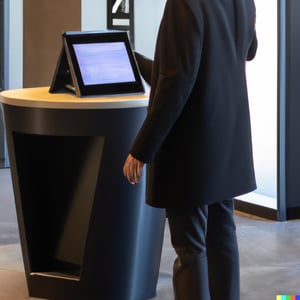Visitor management is an essential aspect of running a successful business or organization.
In the past, visitor management was primarily a manual process that involved paper sign-in sheets, security badges, and hand-written logs.
However, with the advent of technology, digital visitor management systems have evolved into sophisticated digital tools that streamline the process and enhance security.
In this article, we will explore their key features and the benefits of getting one.
We will also look at what you need to keep in mind when choosing the right visitor management system for your organization.
What Are the Key Features?
Electronic visitor management systems typically have several features that help organizations manage visitor traffic effectively.
Some of the most common ones include:
 Digital sign-in sheets: Digital sign-in sheets replace traditional paper sign-in sheets, enabling visitors to quickly and easily sign in using a digital interface.
Digital sign-in sheets: Digital sign-in sheets replace traditional paper sign-in sheets, enabling visitors to quickly and easily sign in using a digital interface.- Pre-registration: Some systems allow visitors to pre-register online before arriving on-site, reducing wait times and speeding up the check-in process.
- Real-time analytics: These help to track visitor traffic in real time, providing insight into visitor patterns and helping to optimize resource allocation.
- Automated reporting: Automated reporting generates reports and analytics on visitor traffic, reducing the need for manual data entry and analysis.
- Background checks: This allows organizations to perform background checks on visitors, ensuring that only authorized individuals are allowed on-site.
- Badging: Digital visitor management systems typically include badge printing capabilities, enabling organizations to print badges for visitors on demand.
- Integration with other systems: Most electronic visitor management systems can be integrated with other systems, such as access control and security cameras, providing a seamless visitor management experience.
- Custom branding and messaging: Some systems allow organizations to add custom branding and messaging to the check-in process, reinforcing their brand and helping to create a positive first impression for visitors.
Electronic visitor management software systems are the modern way of managing the flow of visitors in an organization.
They provide a more efficient and secure solution compared to traditional manual systems and have become a popular choice for many organizations.
Their impact on security and efficiency is particularly of note.
Improved Security
This is one of the key benefits of electronic visitor management systems.
With the ability to pre-register visitors, organizations can ensure that only authorized individuals are allowed on the premises.
The fact that everything is tracked and logged helps the security factor even more, and it largely replaces the role of a receptionist.
Improved Efficiency
 In addition to security, digital visitor management systems also improve efficiency.
In addition to security, digital visitor management systems also improve efficiency.
With digital sign-in sheets, the check-in process is fast and smooth. Automated reporting and analytics also help organizations keep track of visitor traffic, ensuring that their resources are allocated effectively.
By streamlining the check-in process, visitors can spend less time waiting in line and more time focused on their visit.
Digital badge printing, for example, eliminates the need for manual printing, making the process sustainable and convenient.
This enhances the overall visitor experience, creating a positive impression of the organization and fostering strong relationships with visitors.
It also has the added benefit of reducing distractions in the workplace and improving productivity among your workers.
What You Should Keep in Mind When Choosing An Electronic Visitor Management System
Choosing the right electronic visitor management system is a critical decision for organizations looking to improve their visitor management processes.
With the number of options available on the market, it can be pretty tough to know which one will best meet the needs of your organization.
In order to make the right choice and investment, you need to consider several key aspects.
First, consider the size of your organization and the number of visitors you receive on a daily basis.
This will help you determine the level of scalability and functionality that you need in a visitor management system.
A large organization may require a more robust system with advanced features such as pre-registration, background checks, and real-time analytics, whereas a smaller organization may only need a basic system for check-in purposes.
Next, consider the features and functionality that you require from your visitor management system.
Look for systems that provide the features you need to effectively manage your visitor traffic, such as digital sign-in sheets, automated reporting, and badge printing.
You also want to consider the level of customization that is available, such as the ability to add custom branding and messages to the check-in process.
Cost is another important aspect. Electronic visitor management systems can vary widely in price, so it is important to determine your budget and evaluate the price of each system you are considering.
Think about the long-term costs, such as maintenance and upgrades as well.
Finally, consider the integration capabilities of each system.
Ensure that the system you choose integrates seamlessly with your current systems, such as access control and security cameras, in order to ensure an easy visitor management process.
You might need to speak with the product managers or representatives about this.
The compatibility of the system with different operating systems and devices is also essential, as this will ensure that it can be used effectively by all members of your organization or team.
Conclusion
An electronic visitor management system is a wonderful tool that many companies are using these days.
It reduces costs, improves efficiency, and is sustainable in the long term. Some people have raised objections as to how it puts traditional receptionists out of jobs.
However, we are living in rapidly changing times. The livelihoods of all our roles are constantly at risk from new technology.
Getting good at adapting is the best way to secure your future. Visitor management systems have the capacity to transform the office landscape as we know it.